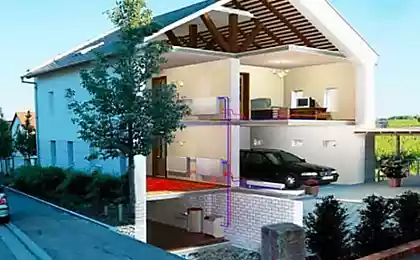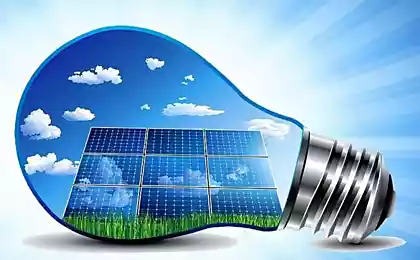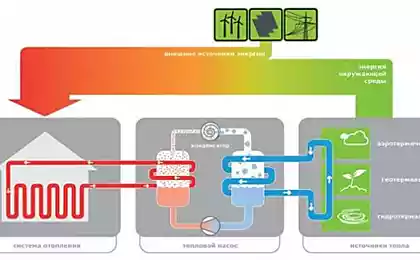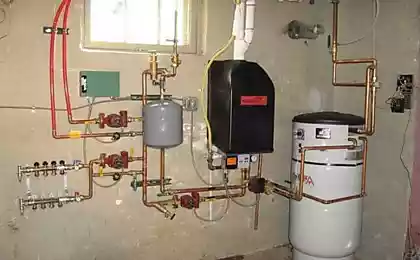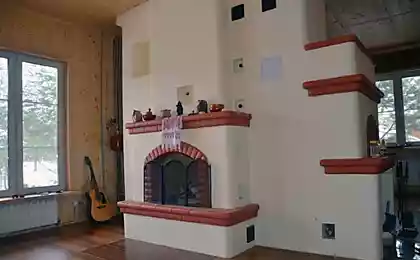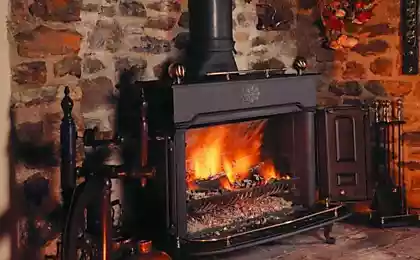515
Air source heat pumps. Applications and operation
Air source heat pump uses energy accumulated in the outside air, and then gives it to the water circulating in the heating system. The cost of installation is much less due to the fact that it is not necessary to pay the cost of laying pipes, a horizontal header or drilling, if the collector is vertical. The cost of pipes, probes, junction wells and antifreeze amount to a significant amount.
The climate of our country is very diverse, so the decision to use air heat pump as the primary heat source or use with other heat generators must take professional.
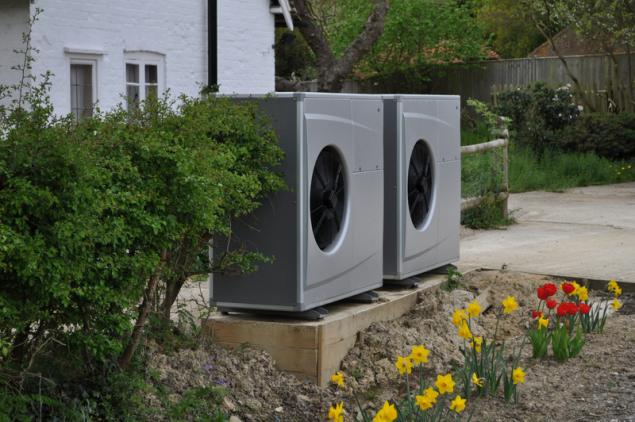
In the winter during severe frosts efficiency air-source heat pumps decreases. By the way, the efficiency of geothermal heat pumps in late winter and early spring is also reduced, and if you look at the SPF (the factor that shows the relation obtained during the season or a specified period of heat of electricity consumed over a specified period), we see that the modern models of air TN are opposed to geothermal TN only 0,51,0 kW. On average, depending on the severity of winter for 1 kW of electricity consumed air TN produces 3.5-4 kW of heat for heating and preparation of hot water, and geothermal TN — 4-4,5 kW.
Equipment manufacturers have made their devices can work at an external temperature of -20 °C, and some premium brands are successfully operating in -25 or even at -28 °C. For 2015 year several manufacturers announced the release of models of heat pumps that can work to a temperature of -32 °C.
Air TN have a niche application. The quantity and quality established in the world and Russia heat pump equipment increases from year to year. Already had a decent domestic models. At the same time we are seeing increased competition, which keeps prices down
When to install air TN
The use of air heat pump for home heating and cooking of hot water is economically justified in the following situations. For example, if near the house there is no network of natural gas. Then the choice we have three solutions. The first is the installation of solid fuel boilers that provide low cost of heating homes, but not very easy to operate. The second is the installation of boilers powered by liquefied gas or diesel fuel. The use of liquefied gas and diesel fuel is quite expensive due to the high cost of these energy, and also need to think about their delivery.
Quite attractive from the investment point of view, the option to install air heat pump. This device requires slightly more capital expenditure, but at the same time it is of minimal maintenance and provides a low-cost operation of the heating system.

The level of thermal protection of buildings is growing, and modern, energy-efficient house, the heat demand is small. Even a few decades ago, the building area of 150 m2 it was necessary the use of the heater capacity of not less than 12-15 kW. Today, quite a 5-8 kW. In this house, even if for some time in the winter to be included in an electric boiler, and in those moments when the air TN are turned off because the temperature drops below -25 °C, the costs will be very small in comparison with the cost of drilling geothermal wells.
When designing a system it is advisable to use Underfloor heating. This solution allows to achieve high energy efficiency and creates a favorable microclimate in the premises, the optimal temperature distribution.
The use of geothermal TN is not always possible. For example, it may be due to too little surface area for laying sewer pipe or lack of permits for the drilling of wells, as well as unsuitable Geology of the site to run with a vertical wells. Sometimes the idea of installing a heat pump appears on the stage when around the house already done by landscape designer, serious interference will cause additional expense. Then, the air pump is the best solution.
Modernization of heating systems of houses that have heat sources on liquefied gas and diesel fuel, installation of air heat pump allows to reduce the cost of the consumed energy by 50-75 %. The pump can be easily combined with an existing installation via a buffer tank.
Where to install air source heat pump
Installation location air heat pump depends primarily on the type of device that best fits the heating system. Produces models monoblock (all components are in one housing) and the split-model (consisting of two parts).
Monoblock air TN internal installation
This heat pump is installed in the house and to the room in which they are located, are two of the ducts. On TV T takes in outside air and removes it after receiving it from the heat. The advantage of this solution is relatively easy to install. The only thing we see on the outside, a lattice fence and exhaust air.
During operation, the pump is pumping huge amounts of air, which is associated with the noise level of the device and air duct channels. In this regard, special attention should be paid to proper selection of the cross section of the channels. In addition, they must be well insulated. Otherwise winter will be cooling and condensation.
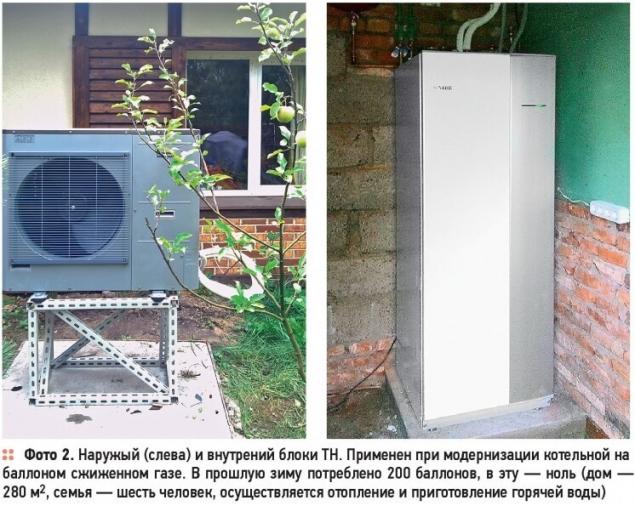
Tip — it is recommended that emission is not too low to the ground, because in winter, it can lead to icing. Also because of the noise generated by the pump during operation, you should not put it in the room adjacent to the bedroom. Release location and air intake must also be installed away from the bedroom Windows.
During operation, the heat pump can produce a certain amount of condensate. In order to remove it, CN can be set on a dense substrate of gravel, in which is placed a drainage pipe with electric
Monoblock air TN outdoor installation
The entire device except the hot water boiler and heat storage tank is mounted on the outside or on the outer wall of the house. In the building are two tubes they connect the pump with the heating system.
The Council — TN must be installed away from the bedroom. But note not to push it too far from home. The farther T will be installed, the longer will be the heating and greater heat loss. It is also important that the air that removes the pump after receiving from him the heat was not directed towards the house, because it can lead to wetting of the walls.
During operation, the heat pump can produce a certain amount of condensate. In order to effectively and simultaneously just delete it, the heat pump can be set on a dense substrate of gravel, in which is placed a drainage pipe with electric heating. It is also necessary to prevent the entry of TONS of snow.
Split-model T
In this category TON outdoor unit (resembles air) receives energy from the environment, and the internal is installed in the house and is responsible for the transfer of heat to the heating system. Both parts are connected by tubes through which circulates the freon (as in a home refrigerator) or antifreeze (as in solar collectors). This type of pumps do not disturb the user during work, because, as a rule, pump part, "responsible" for the noise (grating for ventilation with a fan each circuit of the compressor and the compressor) is located outdoors. In addition, in this embodiment, the water from the heating system passes through the street. So there is no risk of freezing and destruction during interruptions in the supply of electricity.
Tip — when installing the outdoor unit must be guided by the same principles as when mounted monoblock TN. In addition, the manufacturers of these devices are shown in the installation manual for acceptable pipe length between internal and external. They depend on the pump design and range from several to 30 m. published
Source: www.c-o-k.ru/articles/vozdushnye-tn-varianty-primeneniya-i-ekspluatacii
The climate of our country is very diverse, so the decision to use air heat pump as the primary heat source or use with other heat generators must take professional.

In the winter during severe frosts efficiency air-source heat pumps decreases. By the way, the efficiency of geothermal heat pumps in late winter and early spring is also reduced, and if you look at the SPF (the factor that shows the relation obtained during the season or a specified period of heat of electricity consumed over a specified period), we see that the modern models of air TN are opposed to geothermal TN only 0,51,0 kW. On average, depending on the severity of winter for 1 kW of electricity consumed air TN produces 3.5-4 kW of heat for heating and preparation of hot water, and geothermal TN — 4-4,5 kW.
Equipment manufacturers have made their devices can work at an external temperature of -20 °C, and some premium brands are successfully operating in -25 or even at -28 °C. For 2015 year several manufacturers announced the release of models of heat pumps that can work to a temperature of -32 °C.
Air TN have a niche application. The quantity and quality established in the world and Russia heat pump equipment increases from year to year. Already had a decent domestic models. At the same time we are seeing increased competition, which keeps prices down
When to install air TN
The use of air heat pump for home heating and cooking of hot water is economically justified in the following situations. For example, if near the house there is no network of natural gas. Then the choice we have three solutions. The first is the installation of solid fuel boilers that provide low cost of heating homes, but not very easy to operate. The second is the installation of boilers powered by liquefied gas or diesel fuel. The use of liquefied gas and diesel fuel is quite expensive due to the high cost of these energy, and also need to think about their delivery.
Quite attractive from the investment point of view, the option to install air heat pump. This device requires slightly more capital expenditure, but at the same time it is of minimal maintenance and provides a low-cost operation of the heating system.

The level of thermal protection of buildings is growing, and modern, energy-efficient house, the heat demand is small. Even a few decades ago, the building area of 150 m2 it was necessary the use of the heater capacity of not less than 12-15 kW. Today, quite a 5-8 kW. In this house, even if for some time in the winter to be included in an electric boiler, and in those moments when the air TN are turned off because the temperature drops below -25 °C, the costs will be very small in comparison with the cost of drilling geothermal wells.
When designing a system it is advisable to use Underfloor heating. This solution allows to achieve high energy efficiency and creates a favorable microclimate in the premises, the optimal temperature distribution.
The use of geothermal TN is not always possible. For example, it may be due to too little surface area for laying sewer pipe or lack of permits for the drilling of wells, as well as unsuitable Geology of the site to run with a vertical wells. Sometimes the idea of installing a heat pump appears on the stage when around the house already done by landscape designer, serious interference will cause additional expense. Then, the air pump is the best solution.
Modernization of heating systems of houses that have heat sources on liquefied gas and diesel fuel, installation of air heat pump allows to reduce the cost of the consumed energy by 50-75 %. The pump can be easily combined with an existing installation via a buffer tank.
Where to install air source heat pump
Installation location air heat pump depends primarily on the type of device that best fits the heating system. Produces models monoblock (all components are in one housing) and the split-model (consisting of two parts).
Monoblock air TN internal installation
This heat pump is installed in the house and to the room in which they are located, are two of the ducts. On TV T takes in outside air and removes it after receiving it from the heat. The advantage of this solution is relatively easy to install. The only thing we see on the outside, a lattice fence and exhaust air.
During operation, the pump is pumping huge amounts of air, which is associated with the noise level of the device and air duct channels. In this regard, special attention should be paid to proper selection of the cross section of the channels. In addition, they must be well insulated. Otherwise winter will be cooling and condensation.

Tip — it is recommended that emission is not too low to the ground, because in winter, it can lead to icing. Also because of the noise generated by the pump during operation, you should not put it in the room adjacent to the bedroom. Release location and air intake must also be installed away from the bedroom Windows.
During operation, the heat pump can produce a certain amount of condensate. In order to remove it, CN can be set on a dense substrate of gravel, in which is placed a drainage pipe with electric
Monoblock air TN outdoor installation
The entire device except the hot water boiler and heat storage tank is mounted on the outside or on the outer wall of the house. In the building are two tubes they connect the pump with the heating system.
The Council — TN must be installed away from the bedroom. But note not to push it too far from home. The farther T will be installed, the longer will be the heating and greater heat loss. It is also important that the air that removes the pump after receiving from him the heat was not directed towards the house, because it can lead to wetting of the walls.
During operation, the heat pump can produce a certain amount of condensate. In order to effectively and simultaneously just delete it, the heat pump can be set on a dense substrate of gravel, in which is placed a drainage pipe with electric heating. It is also necessary to prevent the entry of TONS of snow.
Split-model T
In this category TON outdoor unit (resembles air) receives energy from the environment, and the internal is installed in the house and is responsible for the transfer of heat to the heating system. Both parts are connected by tubes through which circulates the freon (as in a home refrigerator) or antifreeze (as in solar collectors). This type of pumps do not disturb the user during work, because, as a rule, pump part, "responsible" for the noise (grating for ventilation with a fan each circuit of the compressor and the compressor) is located outdoors. In addition, in this embodiment, the water from the heating system passes through the street. So there is no risk of freezing and destruction during interruptions in the supply of electricity.
Tip — when installing the outdoor unit must be guided by the same principles as when mounted monoblock TN. In addition, the manufacturers of these devices are shown in the installation manual for acceptable pipe length between internal and external. They depend on the pump design and range from several to 30 m. published
Source: www.c-o-k.ru/articles/vozdushnye-tn-varianty-primeneniya-i-ekspluatacii
Roads out of solar panels can test in Russia
Croatian electric car won in the desert drag racing the Bugatti Veyron






